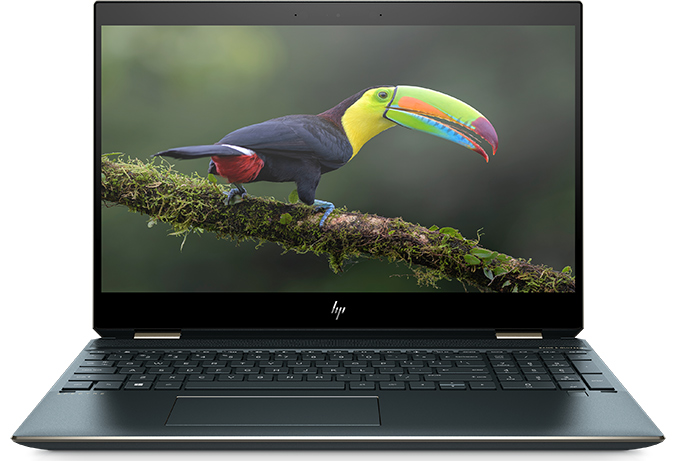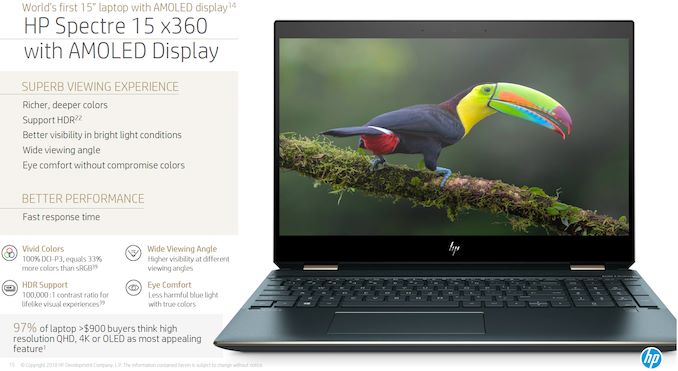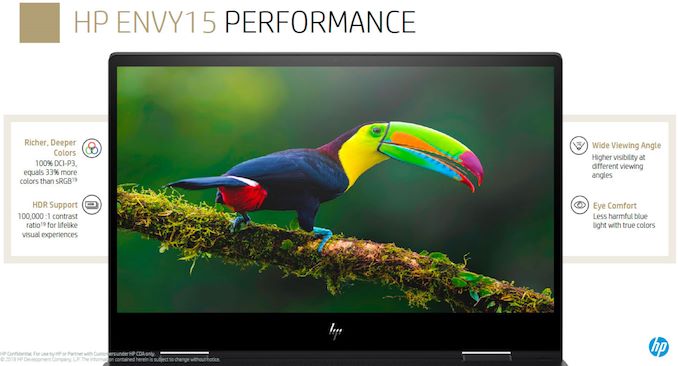HP to Introduce AMOLED Envy and Spectre Laptops in April
by Anton Shilov on March 28, 2019 6:00 PM EST- Posted in
- Laptops
- HP
- AMOLED
- Convertible
- Notebooks
- OLED
- Spectre x360
- Envy x360

HP is on track to start sales of laptops featuring a 15.6-inch AMOLED display in April, the company said recently. The first systems to get the innovative screens will be the company’s Envy and Spectre convertible notebooks that will first be available in Europe and the US.
HP introduced the Spectre x360 15, its first laptop with a 15.6-inch AMOLED display, back at CES 2019. Last week the company disclosed that apart from the said machine, it will also offer a premium version of its Envy x360 15 featuring the same panel. HP will reveal exact specifications of its ultra-thin 15.6-inch laptops with AMOLED displays at a later date, the only thing we do know about them at this time is that they will be based on Intel’s Core ‘Whiskey Lake’ CPUs. Meanwhile, given premium pricing of AMOLED screens, it is reasonable to expect these machines to be offered with other high-end components (GPU, SSD, Wi-Fi, etc.).
The manufacturer plans to start selling the HP Spectre x360 15 convertible via HP.com on April 19 with retail availability through Best Buy expected in May. The Envy x360 15 convertible laptop will be available next month in Europe first, whereas its US launch date will be announced separately, the company said.
Interestingly, HP also has not published many details about the 15.6-inch AMOLED panel it plans to use. So far the only company that has announced a 15.6-inch AMOLED display for laptops so far is Samsung Display. This panel has a 3840×2160 resolution, a brightness level ranging from 0.0005 to 600 nits, a dynamic contrast ratio of 120,000:1, a very low response time, and wide horizontal viewing angles. The screen can reproduce 100% of the DCI-P3 color gamut, which is considerably more accurate when compared to LCDs available today. Furthermore, the monitor carries VESA’s DisplayHDR True Black badge thus supporting at least HDR10 spec. Keep in mind though that HP might use a different panel or different grade of panel.
Related Reading:
- HP at CES 2019: HP Spectre x360 15 Gets AMOLED Display
- Samsung Unveils 15.6-Inch Ultra-HD OLED Display for Laptops
- Lenovo at CES 2019: Yoga C730 Gets AMOLED Display
- Dell at CES 2019: Alienware 55-Inch 4K 120 Hz OLED Gaming Monitor Showcased
Source: HP












41 Comments
View All Comments
skavi - Friday, March 29, 2019 - link
"Electro-emissive or electroluminiscent quantum dot displays are an experimental type of display based on quantum-dot light-emitting diodes (QD-LED; also EL-QLED, ELQD, QDEL). These displays are similar to active-matrix organic light-emitting diode (AMOLED) and MicroLED displays, in that light would be produced directly in each pixel by applying electric current to inorganic nano-particles."QD LED was previously known as QLED before Samsung misappropriated the term.
edzieba - Friday, March 29, 2019 - link
"Quantum LED (not to be confused with quantum dot backlighting - completely different!)"Nope, QLED is just Samsung's marketing term for QD backlighting. Same marketing technique as "LED TVs": swap the backlight, pretend it's an entirely new panel technology.
skavi - Friday, March 29, 2019 - link
Before Samsung misappropriated the term, QLED referred to a possible future display tech which utilized the electroluminescent properties of QDs to use them directly as subpixels. Current Samsung "QLED" displays just use QD's photoluminescence to improve backlight quality.Valantar - Friday, March 29, 2019 - link
Care to share a link to a photo of your display showing a full-screen white image at medium or higher brightness? I'm genuinely curious, especially in the task bar area. There are limits to how effective "rest" is for alleviating color dimming through wear on OLED subpixels.nathanddrews - Friday, March 29, 2019 - link
I'd like to see evidence as well. OLED burn-in a question of "when", not "if". I love OLED and have several OLED devices, but even I can admit its flaws. The OP is actually doing himself a disservice by using dark mode due to the higher contrast between off and on pixels. The more unevenly the pixels wear, the more noticeable burn-in will become. For equipment that you're going to replace within 3 years anyway, you probably don't have to worry about it, assuming you keep brightness at medium/low (good job, OP) and get a lot of varied content.The most comprehensive burn-in tests (rtings) test both max brightness and regular brightness and run the pixel refresher every power cycle (every 4 hours). 5 hours on, 1 hour to "refresh" pixels, four times per day. They all burn-in - the higher brightness displays burn-in more heavily than the lower brightness displays. LG itself acknowledges that total "on" time is all that matters - doesn't matter if it's 1 hour per day or 24 hours per day. They burn-in, starting with red.
QLED is the use of quantum dot tech as part of the LED fabrication process. It wasn't too great with the first few generations, but the newer QLED panels with stacked LCDs are more zone control are really starting look significantly better than traditional LCDs.
These are all stopgaps, I think. The real future of display tech is MicroLED - using non-organic RGB LEDs. Sony CLEDIS, Samsung Wall, etc. Once they get a few more shrinks and energy usage under control, it's going to be the GOAT. I've already got a savings account set up explicitly for buying one in 2024. LOL
Reflex - Friday, March 29, 2019 - link
"They burn-in, starting with red."This statement really isn't true. LG panels don't have individually colored OLED pixels, they are all white with a filter (they call it a 'color refiner') over the top. This is how they avoid the issue of certain colors degrading more quickly or burning in more rapidly.
https://www.oled-info.com/lgs-8-gen-line-will-prod...
(hope that image link works)
SaturnusDK - Saturday, March 30, 2019 - link
Apologizes for not seeing the request for picture evidence before but here goes. Please look away from smudges as it is a touch screen and I do use that functionality. This is a close up from the bottom of the screen where the task bar is at 80% brightness.https://ibb.co/86qV8Z9
Spunjji - Sunday, March 31, 2019 - link
If I nitpick, I *can* see a line towards the bottom of the screen in that image where the display appears to be brighter, and it corresponds to where the Windows 10 task bar would be.Definitely nitpicking, though - and I can't imagine a single scenario where it would be relevant. Consistency across the display is usually quite poor with most LCD displays anyway, so it seems like the problem is less "it's bad" and more "it's no longer perfect".
Thanks for sharing! :)
SSTANIC - Friday, March 29, 2019 - link
No problems with burn-in, Samsung Windows tablet, 1440p resolution, bought ~3 years ago, AMOLED screen. After some time of static-on-time it automatically goes off/screensaver, it is completely unintrusive. Picture quality for reading and video is simply spectacular, way beyond any LED laptop screen.ied - Thursday, March 28, 2019 - link
I despise notebooks with these stupid sized display top/bottom borders. If you're making a machine sized A x B, then the LCD should have the same A/B ratio.Cellphones catch hell for a few millimeters of borders, but laptop vendors get a pass. This thing could easily fit a 16:10 panel, maybe 3:2, but nope...
We get something plain ugly, with a gigantic logo. Uuuggg...